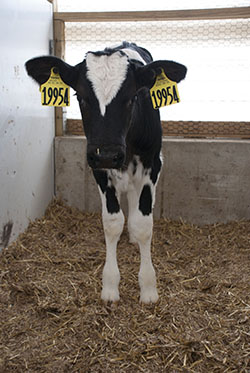 "It's tough to fix an engine until you know how it works. The same is true for respiratory disease in calves." This is the philosophy of Darren Katzung, D.V.M., a large animal veterinarian at Southwest Veterinary Service in southwestern Wisconsin. Katzung spoke at the Dairy Beef for Profit workshop hosted by Iowa State University Extension last week.
"It's tough to fix an engine until you know how it works. The same is true for respiratory disease in calves." This is the philosophy of Darren Katzung, D.V.M., a large animal veterinarian at Southwest Veterinary Service in southwestern Wisconsin. Katzung spoke at the Dairy Beef for Profit workshop hosted by Iowa State University Extension last week.To better troubleshoot respiratory disease on the farm, it is useful to be familiar with the parts that make up that body system. The respiratory system consists of the upper and lower tracts. The upper respiratory tract includes the nasal cavity, pharynx and larynx. The lower tract contains the trachea, bronchi, bronchioles and alveoli.
Katzung listed the five most important defense mechanisms of the respiratory system as the mucociliary escalator, phagocytic activity, guard hairs and sticky mucus covered surfaces, normal flora and specific immunity. These defense mechanisms are what protect the respiratory "engine" from disease.
Defense mechanisms form a great barrier, but unfortunately, calves still get sick. Pneumonia, one of the biggest respiratory challenges calves face, is an infection of the lungs that is caused by bacteria, viruses, fungi or parasites. It is characterized primarily by inflammation of the alveoli in the lungs or by alveoli that are filled with fluid.
Calves get pneumonia and other diseases when defense mechanisms fail. What causes them to fail? That question has a multitude of answers, noted Katzung, and he shared many with the group. Poor air quality leaves dust in the air, which can overwhelm the mucociliary escalator. Ammonia fumes and hydrogen-sulfide gas slow down the cilia, preventing them from doing their job. Stocking density in pens also wears down defense mechanisms, increasing the number of potential pathogens in the immediate environment.
Antibiotic overuse or misuse may alter the population of normal flora, or good bacteria, and allow pathogens to take hold. Dehydration raises viscosity of the mucus, making it more difficult to move and remove harmful bacteria out of the calf.
Acidosis affects the cells of the immune system, and a weakened immune system allows disease to settle in. Stress hormones also elevate cortisol, which results in excessive mucus production.
A naïve immune system, the result of no previous exposure to the disease or vaccination that occurred at a time of stress, is a cause of failed defense. Lastly, weather, including heat, cold, extreme temperature variations or fog can weaken defense mechanisms.
Even though pneumonia is caused by pathogens, it is the breakdown in defense mechanisms that allow the invasion of pathogens in the first place. Rather than simply patching the respiratory engine by treating the disease, farms could benefit by better understanding the calf respiratory system and what is causing the defense to slip. This concept is true for troubleshooting any disease in the herd. "Sometimes farms may find it is easier to fix the actual problem than to continuously apply Band-Aids," explained Katzung.

The author is an associate editor and covers animal health, dairy housing and equipment, and nutrient management. She grew up on a dairy farm near Plymouth, Wis., and previously served as a University of Wisconsin agricultural extension agent. She received a master's degree from North Carolina State University and a bachelor's from University of Wisconsin-Madison.









